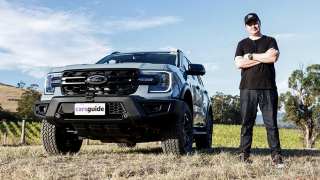
Top 5 tips for camping in a camper-trailer

Camper-trailers add a whole new dimension to your camping game - they provide highly mobile accommodation and can be set up in minutes anywhere and everywhere. But how do you get the most of them and ensure that you have a great time away while you’re camping in one?
Well, if you haven’t already, read our yarn on easy ways to track down the ultimate campsite for you and your mob, and our feature on how to tackle your first camping trips away, and our top 5 tips for a great camping trip. Sure, a lot of the same rules apply to camping with a camper-trailer but there are a few camper-specific pointers you should keep in mind.
So, whether you’re simply entertaining the notion of buying a camper-trailer, have just bought one, or have had one for years and just need a quick refresher, here are our top 5 tips for camping in a camper-trailer.
Before you go – Make sure your camper is ready for towing

Some of the most crucial things you can do to ensure a great camper-trailer trip need to be done before you even actually set foot in your tow vehicle and drive off in the general direction of your campsite.
By now you will have made sure your tow vehicle and its tyres (including the spare) are in tip-top shape, so it’s time to check your camper.
Make sure the tyres on your camper are in good nick – tread depth needs to be more than the minimum roadworthy tread depth of 1.5mm. Worn-out tyres can be dangerous, and any rubber more than six years old – no matter how well-preserved they appear to be – should be replaced with new tyres.
Check that the camper’s tyres are free of slow leaks, cuts, chips, penetrating damage (a screw, nail etc) and any other damage that may present problems while you’re away – scrutinise the tread and side walls.
Under- or over-inflated tyres can affect handling, so check tyre pressures prior to departure and monitor and maintain uniform tyre pressures during the trip.
Check the camper’s braking and taillights (lightbulbs and wiring) to ensure it’s all working without trouble.
Check the camper’s suspension – leaf-spring or coils – for any signs of potential strife.
Before you go – Make sure everything on your camper works

Before you travel, make sure everything on your camper is in good working order.
Sounds like pretty obvious common sense, right? Of course, it does, but still people, in their hurry to get going on a camping trip, often forget to check that everything on the camper – wiring, batteries, lights (interior and exterior if applicable), taps, gas connections … everything – is clean, functioning and ready for the trip.
A good idea is to set up the camper in your backyard: open everything up and out – including all beds – to ensure every feature is in camp-ready condition, including the camp kitchen, fridge and any other camp-related necessities.
If you don’t have the chance to do a full set-up – or if you’re just too bloody lazy to – then take a good walk around the camper prior to departure and scrutinise as many features as you can, inside and outside.
Make sure, among other things, all canvas sections are damp- and rip-free, mesh screens are intact, awning poles are free of dings or bends, all hinges work smoothly, gas bottles are full – really anything and everything.
Do a thorough check-through of your camper before you head off on any trip and you’ll likely prevent most minor or major repairs or delays, thus saving yourself time and money.
Sub-head: At camp, set up on flat, level ground

Again, common sense but it needs to be stated. Find a good-seized area of flat, even, firm, level ground – free of irregularities (rocks, tree roots, potholes etc) – and position your camper there.
Bear in mind, that a camper will, once set up, settle into the surface a bit with time and under the weight of its residents and general usage.
Obviously, prior to any attempt at setting up your camper, you will have already deployed the jockey wheel, screwed its bracket on tight to prevent any unwanted jockey-wheel movement (up, down or sideways), wound the jockey wheel up to the optimal height (helping to ensure the entire camper is level), and engaged and locked the trailer’s handbrake in position.
Before set-up, check all latches, clips and canvas

It’s kind of part of the first tip (‘Make sure everything on your camper works – before you go anywhere’) in this yarn, but it deserves its own section because it’s so simple to forget and yet so bloody important.
Make sure all latches, clips and locking points are unfastened before you try to unfold/wind up/set up your camper – or you may waste precious camping time trying to figure out why your camper-trailer does not budge when you try to open it up at the campsite.
Also, make sure no canvas is caught in any potential pinch-points, which will hamper your set-up process or, worse still, tear or otherwise be damaged when you attempt to force things into place when they’re actually caught on something which is preventing them from being properly deployed.
Use the camper’s stabilisers

It’s not enough to lock the jockey-wheel in position and engage the trailer handbrake – those actions certainly help, but you also need to, once the camper is set-up, make sure that all stabilisers are deployed, in position and locked securely in place.
Most, if not all, campers have several stabiliser struts or poles at various positions under the main body of the camper and also under other required sections – a bed, for example – in order to keep all camper areas secure and in place.
Don’t be lazy with these – use all of them – because they’ve been engineered and built into your camper for a very good reason.








Comments